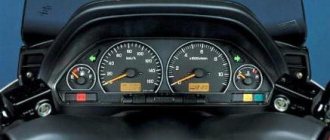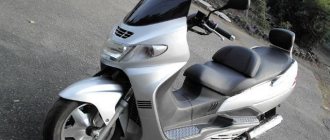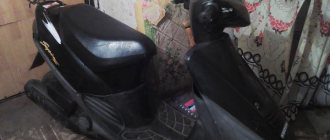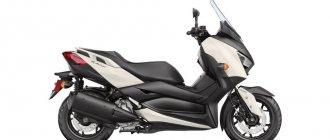What is a maxi scooter
When you first look at a scooter with impressive dimensions, a voluminous body kit and two comfortable seats, you immediately understand that this is a maxi-scooter. It’s not for nothing that motorcycle enthusiasts often call large scooters “sofas,” which is due to their increased size and increased degree of comfort.
Suzuki Burgman 650 is one of the largest production models of maxi-scooters
Large scooters have a powerful and energy-intensive suspension, increased wheel diameter, and the engine cylinder is not inferior in cubic capacity to a powerful motorcycle and develops a fairly large torque. At the same time, there may be no traditional motorcycle gearbox, instead of which an automatic transmission is sometimes installed.
The braking system on maxi scooters is more reliable. After all, when driving at high speeds, it is important to be able to quickly stop the vehicle. This is why drum brakes are not installed on large and massive scooters.
Typically, there is a disc brake consisting of one or two discs on the front and rear wheels.
In a large scooter, everything is done for convenience and safety during long trips - the trunk has increased capacity, a comfortable backrest supports the driver’s back, and protection from precipitation and wind has been thought out. Riding a maxi scooter around the city is inconvenient due to its increased size.
Having figured out how a maxi-scooter differs from a regular one, let’s dwell on the features of the Burgman 650 model, manufactured by Suzuki.
During long journeys, a large scooter is comfortable and safe
Photo gallery
The Suzuki Burgman (Suzuki Skywave) 650 fascinates with its impressive dimensions and vaguely resembles full-size tourist cruisers. Leadership in the class is ensured by outstanding driving performance, and dynamic characteristics are not inferior to mid-sized motorcycles. And you can get acquainted with its excellent design in our selection.
A Brief History of the Suzuki Burgman Model Range
Suzuki specialists, who have perfectly mastered the production of scooters for mass consumers, decided to create equipment that is not inferior in technical characteristics to motorcycles. The first models of large scooters, called Burgman, were released 20 years ago. After the appearance on the market in 1999 of a modification of the Suzuki Burgman under the AN250 brand, the engineers did not stop there and released another model, the AN400.
Developing the model line, a few years after the release of the first maxi-scooters, the AN125 model was manufactured. In 2002, it made an impression on fans of large devices. However, this modification did not remain a new development by Suzuki specialists for long. A year later, the Suzuki Burgman 650 model appeared, and in 2004, a modernized version of the 650 model called Executive.
Engine
The device is driven by a 638 cc four-stroke two-cylinder liquid-cooled engine. cm, with a piston size of 75.5 mm and a stroke of 71.3 mm. The engine has two camshafts located in the head on parallel cylinders. The mixture is prepared by an injector that has feedback through an oxygen sensor in the exhaust, and an additional air supply to the exhaust mixture allows you to burn out all unburned hydrocarbons and squeeze the exhaust gases into modern economic standards. The engine contains two balancer shafts, therefore, despite the large volume, the engine vibrates very slightly, and this is difficult to overestimate.
The power figures are quite significant: 56 hp. at 7000 rpm and 62 N*m at 5000 rpm, due to which the maximum speed of the device is about 160 km/h. Thus, the engine of the device is quite ordinary, which cannot be said about the transmission.
Its transmission is unlike a motorcycle transmission, with mechanical gear shifting, or a scooter transmission with a conventional variator, in which the gear ratio smoothly changes due to an increase in the centrifugal force acting on the variator weights. Suzuki Electric CVT is an electronically controlled CVT that has two automatic operating modes - Drive and Power, and also a manual gear ratio mode that emulates a six-speed gearbox. In Drive mode, the device has a linear acceleration characteristic, and in Power mode, acceleration is improved by using higher torque at higher speeds. This will undoubtedly appeal to those who like to get the most out of the device.
General description of Suzuki Burgman 650
Trying to characterize the 650th model, it would be more correct to call it a motorcycle that looks like a scooter. After all, the driver’s seating position is the same as on a regular scooter, called a “stool.” At the same time, the level of functionality and comfort corresponds to touring motorcycles. In the Japanese market this scooter model is called Skywave, and in European and American markets it is called Burgman. Structurally and externally, both models are identical. Let's look at their design and construction.
The shapes of the 650th model of the Burgman scooter are expressive
Appearance and design
Looking at the 650th model of the Burgman scooter, you are surprised at how expressive the shapes and impressive dimensions are. Noteworthy is the volumetric lining made of high-quality plastic, which gives this model solidity. The aerodynamics are well thought out - the windshield is like a visual continuation of the skin and gives the front part an arrow-shaped shape. Two powerful headlights located above the front fender provide good illumination.
Bright turn signals are located in the folding side mirrors, located slightly above the headlights. There is an electric drive for changing the angular position of the windshield, which increases comfort while driving. The windshield covers the dashboard display, which provides essential information about the scooter's operation. The space between the steering column and the driver's seat is used to accommodate closed storage boxes.
The comfortable seat has a stepped shape and is equipped with a driver's backrest with the ability to adjust its position. For the convenience of passengers, there are two handles on opposite sides of the plastic body kit. Comfortable platforms are provided for the feet of the driver and passenger. Under the seat there is a storage container with a volume of 56 liters.
Japanese engineers thought through all the components of the maxi-scooter in detail.
Design
Japanese engineers thought through all the components of the maxi-scooter in detail. The supporting structure is made of a tubular profile and forms a rigid frame to which a plastic body kit is attached. Unlike the typical small scooter arrangement of the engine located next to the rear wheel, the maxi scooter has the power unit located under the driver's seat.
To maintain the operating temperature of the two-cylinder engine, a liquid cooling system is installed. The radiator is conveniently located at the front of the scooter in close proximity to the front wheel. It receives a powerful air flow, providing effective cooling of the motor. Externally, the radiator is not visible, as it is successfully hidden under plastic.
The developers used the right side of the scooter to locate the exhaust pipe. The possibility of burns from the top and side parts of the hot muffler, which are hidden under the protective cover, is eliminated.
The scooter is equipped with a CVT gearbox, which differs from a classic motorcycle with a gearbox. It provides quick acceleration and the ability to ride comfortably on a maxi-scooter. The transmission can operate in two modes, one of which is automatic and the other with manual gear shifting.
The scooter is equipped with a CVT gearbox
The pendant has a classic design. The front wheel is mounted on a telescopic fork, and the rear wheel has a pendulum suspension and is mounted on two lateral shock absorbers. The front wheel of the scooter is locked by two disc brakes, and the drive wheel by one.
Service
Tire pressure
Cold tire pressure should be:
- front: 2.25 kgf/cm2 both with and without a passenger
- rear: 2.5 kgf/cm2 without a passenger, 2.8 kgf/cm2 with a passenger
These values are valid for standard tire sizes: 120/70 R15M/C 56H for the front and 160/60 R14M/C 65H for the rear.
Change of oil
Unlike conventional scooters, the oil in the Burgman 650 needs to be changed in as many as three places: in the engine, in the transmission (sometimes mistakenly called the “clutch”), in the main gear (which is sometimes called the gearbox, which is also not entirely true).
Engine oil
It is not recommended to use so-called “energy conserving” oils!
| API | ||
| 10W-40 | SF or SG | – |
| 10W-40 | SH or SJ | M.A. |
Required oil volume:
| Simple replacement: | 2.6 l |
| With filter replacement: | 2.9 l |
| Engine overhaul: | 3.4 l |
The oil is changed every 6,000 km (6 months), the filter every 18,000 km (18 months).
The drain plug is tightened with a force of 23 N m.
Transmission oil
Do not confuse the transmission with the final drive! The transmission is in the middle.
Required transmission oil volume:
| Simple replacement: | 360 ml |
| Major repairs: | 400 ml |
Replacement interval every 12,000 km (12 months), level check every 6,000 km (6 months).
All plugs (filler, drain, level plug) are tightened with a force of 12 N m.
Final drive oil
It is recommended to use SAE90 hypoid oil, which has an API rating of GL-5.
Replacement interval every 12,000 km (12 months).
Required volume:
| Simple replacement: | 300 ml |
| Major repairs: | 430 ml |
All plugs (filler, drain) are tightened with a force of 33 N m.
Wheel bearings
Single-row radial ball bearing
In early versions of Burgman (presumably before 2003), there was a problem with the front wheel bearings - they became unusable literally within 5-10 thousand km. Then this problem was corrected by simply replacing the semi-closed bearings with closed ones.
When replacing, it is recommended to use bearings with the index ХХХХ-2RSH - according to observations, they last 30-40 thousand km on average.
Original bearing numbers for Suzuki Burgman (Skywave) 650:
| Front: | 08133-62037-000 (2 pcs.) |
| Rear: | 08123-62047-000 (2 pcs.) |
Suzuki Burgman 650 – technical specifications of the scooter
The Suzuki Burgman 650 Executive scooter has quite impressive dimensions. The length of the vehicle is 2.26 m, and the width and height are 0.81 and 2.26 m, respectively. The driver's seat is located at a distance of 75.5 cm from the road surface. The distance between the axles of the front and rear wheels is 1,595 m, and the ground clearance reaches 13 cm. The curb weight of the maxi-scooter does not exceed 280 kg.
The four-stroke two-cylinder engine has a fairly decent cubic capacity of 638 cm3 and develops a power of 54 hp. This allows the massive device to accelerate to 190 km/h. Only an experienced driver can operate a heavy scooter at high speed.
The engine with an injection power system has a double-row cylinder arrangement and liquid cooling. The power unit is started from an electric starter.
The engine design, developed for sports motorcycles, has not changed since Suzuki released the first maxi-scooters. Transmission of torque from the engine through an automatic transmission allows the engine to reduce gasoline consumption in the Burgman model by 14-16%. Depending on the driving style and speed limit, the engine consumes from 3.8 to 6.5 liters of gasoline per hundred.
The 650th modification of the Burgman scooter is suitable for long trips
When looking for a motorcycle for a long trip, you should pay attention to the 650th modification of the Burgman scooter, equipped with a comfortable seat, a 15-liter fuel tank and a powerful engine. The capacity of the fuel tank allows you to easily cover long distances with one refueling.
Classmate
Suzuki positions its Executive as a device in the top segment of the market, so it only makes sense to compare it with another serious player. Luckily, BMW has the C650GT, which makes the Executive very easy to match. The devices are almost identical in their characteristics, both have high windshields, mirrors on the fairing with built-in turn signals, and a driver’s backrest, but in terms of the presence of a passenger backrest, BMW is behind. The BMW's suspension is more typical for a scooter, with a single engine-transmission-wheel unit, so it has more unsprung weight. The braking system is almost the same on both vehicles, including the presence of ABS. The GT engine has a little more horsepower - by as much as 4 - and almost the same torque as that of its competitor, so it essentially does not provide any gain in power. It turns out that when choosing one of these devices you need to be guided by taste, not characteristics.
Review of advantages and disadvantages
The Suzuki Burgman 650 maxi-scooter has a number of serious advantages. Main advantages:
- automatic variator with the ability to switch to manual mode;
- powerful power plant providing quick acceleration;
- the ability to work on gasoline with an octane number of 92-95;
- heated steering grips and seat surfaces;
- high-quality optics that allow you to drive in low visibility conditions;
- increased volume of the luggage compartment, allowing you to place helmets and things;
- convenient placement of mirrors providing increased visibility.
In addition, the thoughtful placement of the seat and steering wheel ensures a comfortable driving position, which is important when covering long distances.
The Suzuki Burgman 650 maxi-scooter has a number of serious advantages
Along with the advantages, this model also has weaknesses:
- increased weight and dimensions make it difficult to control the vehicle, especially in heavy traffic;
- deterioration in scooter controllability for a short period of time when quickly reaching the speed limit;
- the possibility of losing control of a vehicle stopped by emergency braking at high speed.
Controlling a scooter takes some getting used to - the many switches located on the steering wheel sometimes make novice drivers think. In addition, a tall driver will have to move closer to the passenger seat to ensure a comfortable foot position on the platform.
Consumables
Numbers of original and non-original consumables, approximate prices, appearance, features.
Brake pads
from the manufacturer TRW:
Before the MCB598SRM (there are 2 brake discs at the front, accordingly we order 2 sets), the approximate cost of the set is $15-20.
Rear MCB751
Only this number! Any alternative option, for example MCB571, will not work, because it does not have a pin on the back side of the pad, which is important to install on the side of the brake barrels, this is important for the operation of the handbrake, without the pin the handbrake will not work well, increased wear of the pads
Oil filter
Original Suzuki 16510-07J00, replacement Knecht OC 574 or its equivalents.
Oil change interval is every 6 thousand km, filter change interval is every 18 thousand km.
Oil filter
Test drive Suzuki Skywave 650 Burgman
The Suzuki Burgman 650 2022 scooter is easy to control at speeds up to 100 km/h. Exceeding this threshold forces the driver to strain, as difficulties arise in maneuvering while driving a massive and oversized vehicle. At low speeds the driver feels comfortable. However, when cornering, the heavy scooter moves rather sluggishly, as the driver has to maintain its balance.
A test drive of the scooter showed that it is quite dynamic, but requires driving skills for safe operation.
Miscellaneous
How to count FI errors
If the FI (Fault Indicator) lamp lights up, then errors can be read as follows. Under the seat, near the fuses, we find a white connector that does not have an angular contact. We close two wires - white-red and black-white. Then turn the ignition key and look at the dashboard, where the error code should be displayed.
This must be done at the moment when FI is lit. If you turn off the ignition to open the seat, the error will be reset. Therefore, it makes sense to make wires in advance in order to close the contacts without raising the seat (or drive with the diagnostic mode always on).
Seat shock absorber, alternative
The original seat shock absorber comes under part number 45270-10G00-000 and costs very good money. You can use an alternative option from the trunk glass of a Hyundai Santa Fe, article number 8717026011. You will only need to weld the fastening shanks from the old shock absorber to the new one (they cannot be unscrewed from the original shock absorber, just cut off and welded).
How to disassemble a mirror
Using a hair dryer, the rim of the mirror is evenly heated to a temperature of at least 60 degrees Celsius. Afterwards, the edge is picked up with a knife or spatula and the mirror comes out of the frame.
If the temperature is insufficient, there is a risk of damage to the mirror itself. When overheating, you need to understand that the higher the temperature, the more the plastic of the rim softens. First of all, you should not bring the plastic to the melting point, because a spatula or knife will leave an irreparable mark on the surface of the plastic. Total 70-90 degrees is the comfort zone.
There is a screw under the mirror, unscrewing which will detach the frame. The reverse process also occurs through heating - the mirror is pressed into the frame.
You need to start “picking out” from the narrowed side. The wider one “jumps out” itself. Paste in reverse.
003_MOTO_0410_033
INDIVIDUALIZATION. With tuning “burgs” (in the technical sense), things are a little tight. Unlike the 400th model, which comes with all the imaginable bells and whistles, the list of factory and aftermarket options is quite meager, so it’s not possible to build a rocket out of a “burg.” The only thing that sellers offer to “pick up” the car is a power commander, which, together with a direct-flow “can” of a muffler, is capable of increasing engine power by 5–7 forces. By the way, the choice of tuning exhaust systems is also small: Leo Vince and Yoshimura have only one model of “cans”. You can complete the list of available tuning with the already mentioned set of suspension springs. Probably, such scarcity is due to the fact that Burgman is still considered a representative of the “business class”, and respectable guys in jackets are not supposed to “have a blast”. But for those who like to stand out from the crowd of their own kind, there is somewhere to turn around. The voluminous sections of the catalogs of leading manufacturers offer a lot of all kinds of carbon and wood trims, visors, light bulbs, mules and pieces of iron, and specialized companies offer all kinds of lighting. So the question of individualization is limited only by the thickness of its owner’s wallet.
Article on the topic: Mazda 2 owner reviews disadvantages
Honda FJS 600 Silver Wing (2001–2008, RUB 120,000–300,000)
The first generation Silver Wing in the 600 cc version is one of the most popular and in demand maxi-scooters. The model has long been discontinued, but the popularity of the Japanese “sofa” with a memorable diamond-shaped headlight has only grown over the years.
Engine
The 582cc eight-valve parallel twin with electronically controlled fuel injection and liquid cooling is fantastically reliable. It does not consume oil even in the most advanced cases. No sores or weak points were noticed. With adequate maintenance, the engine can easily last 100,000–150,000 km without major repairs.
Transmission
The CVT transmission is designed as is, with absolutely no bells and whistles. Which has a positive effect on resource and reliability. The mechanism is similar to that of a fifty-kopeck scooter. Weights, pulleys and belt. Nothing more! The result is a non-violent character (for fans of dynamics, it makes sense to sharpen their skis in the direction of expensive tuning), which is more than compensated by reliability that borders on the fantastic.
Frame and body kit
At the current time, the frame design can already be called obsolete. The spatial steel part does not have sufficient rigidity, which does not have the best effect on handling.
Silver's plastic is dense and thick. The abundance of mounting eyes is not the best for long-term use. Fasteners often suffer during repairs; plastic parts begin to rattle and join with an uneven gap.
Brakes
The braking system is Silver's strong point. Despite the absence of a second brake disc on the front wheel. All 600 cars are equipped with a combined brake force distribution system. When you press the front brake lever, the two pistons of the front caliper are activated. Pressing the rear brake lever activates one front caliper piston and two rear caliper pistons.
Pendants
The chassis of the Honda FJS 600 Silver Wing, so to speak, is designed strictly according to scooter canons. Without introducing solutions from the world of cubic motorcycles. The fork is short and flimsy, without additional yokes. Hence the lack of rigidity, which, together with a not very monumental frame and a simple rear suspension with two shock absorbers, reduces the “driver’s” to a minimum. The suspension is generally strong and reliable, but unlike many competitors it is not conducive to active, almost sporty driving.
It is worth paying attention to the mounting ears of the rear shock absorbers and the engine-frame “rocker”. Driving on roads of poor quality may cause serious gaps and cracks in these places.
Comfort
The standard windshield on the Honda FJS 600 Silver Wing is large, but not adjustable. Tall drivers will have to order aftermarket windshields or additional add-on sections. The suspension, despite its incapacity for hyperactive steering on uneven surfaces, behaves extremely adequately. The scooter passes through potholes, joints and other misunderstandings smoothly and softly. Tall drivers may feel uncomfortable driving the Silver. An individual with a height of over 190 cm is guaranteed to rest his knees on the front panel.
Modifications
Silver Wing debuted in 2000. There are two cubic capacity options at once - 400 cm3 and 600 cm3. In 2002, the relay regulator was moved under the fairing. In 2003, a “Mode” button appeared, allowing you to slightly “cheer up” the injection maps, and ABS also appeared as an option. In 2004, a slight restyling took place - the shape and fastening of the glove compartment lids changed, the headlight reflector housing became chrome-plated, the material of the seat upholstery changed, the instrument panel lighting became brighter, the lower fork cups and rims began to be painted black. In 2006, an immobilizer and side lamps in the headlight appeared, and the display backlight on the dashboard became blue. In 2008, Honda polished up the Silver for the last time before the generation change. Distinctive features are gold-colored wheels, calipers and nameplates, as well as carbon-fibre seat trim. In 2009, the design was radically updated, and changes were made to the engine.
Design
If I were to describe it in a nutshell, it would be “Richly equipped.” Let's start with wheels that are quite large for a maxiscooter, and this is a good start, because on regular 12-inch scooter wheels, large devices look a little comical.
The dual front brakes add serious gravitas, as does the sports-touring-style front fairing that covers the radiator and extends into a windscreen for the legs. Above is the dashboard, a pair of glove compartments and the first few luxury features associated with the top model in the lineup. Not only is the windshield powered for on-the-go adjustments, but the mirrors fold in and out at the touch of a button. A somewhat unexpected function, but quite justified given its considerable width: it is better to fold them than to break them when driving in a row, or squeezing into a narrow space in a parking lot.
The top positioning of the scooter in the line is evident from the thoughtful comfort of not only the driver, but also the passenger. This stock unit is equipped with excellent heating: it has warm handles, as well as heated driver and passenger seats
The driver's seat is equipped with an adjustable backrest, and, which is not often the case on scooters, the passenger seat also has a backrest, which, of course, is important for the safety and comfort of the passenger
The 50-litre under-seat boot will fit a pair of medium-sized helmets. At the same time, the manufacturer equips the device with a special loop for attaching a helmet, which allows you to use the space under the saddle for other loads. There will be few color variations this model year, but the double white stitching really brightens up the seat, and the black brake levers look stylish and harmonious with the rest of the controls and instrument panel.
When viewed from the rear, the passenger backrest stands out somewhat at first glance, but the wide body, large light fixtures and massive mudguard (also known as the license plate holder) smooth out this impression. Overall, the Executive looks like a serious and stylish scooter that will undoubtedly appeal to its mature and serious target audience - young professionals commuting to work downtown from an expensive suburb.
CVT (SECVT)
The CVT of the Suzuki Burgman 650 is radically different from any CVT of other scooters. Actually, this is the main reason for fears in purchasing this model - many craftsmen simply do not know how to properly maintain it. However, there is enough information on the Internet on maintenance and overhaul at home.
Stop bolt
AN650 variator locking bolt, minor wear
The variator drive pulley locking bolt also performs an inspection function. If severe wear is detected on it, then this indirectly indicates possible problems with the variator bearings.
The bolt is located at the bottom of the variator; it is not necessary to remove the plastic to access it. Tightens with a tightening torque of 36 N•m.
From year to year, the manufacturer changed both the hardening of the locking bolt and its length. Be careful when replacing with a new one - a long bolt can damage the variator!
009_MOTO_0410_034
BUSINESS CLASS TICKET. Prices for used Burgs and Skyes vary widely. It all depends on the mileage and general condition of the car, as well as on tuning, because sometimes the cost of “sound” on a scooter comes close to the price of the device itself. True, the market also offers an abundance of copies untouched by the tuner, so there is always a choice. Copies of the first years of production with a decent mileage are offered from 200 thousand rubles, and sometimes even lower, but when choosing a device from the lower price range, it is worth considering that a possible overhaul of the engine and variator can greatly undermine even a fairly solid budget.











